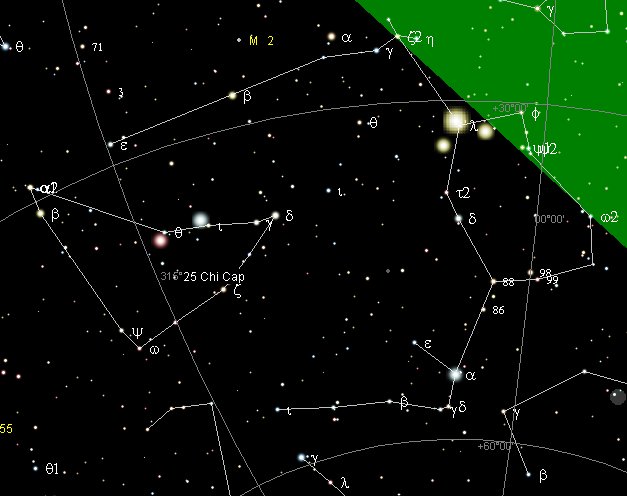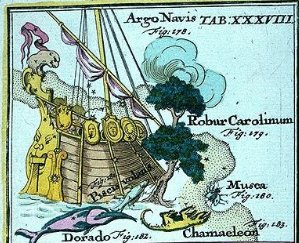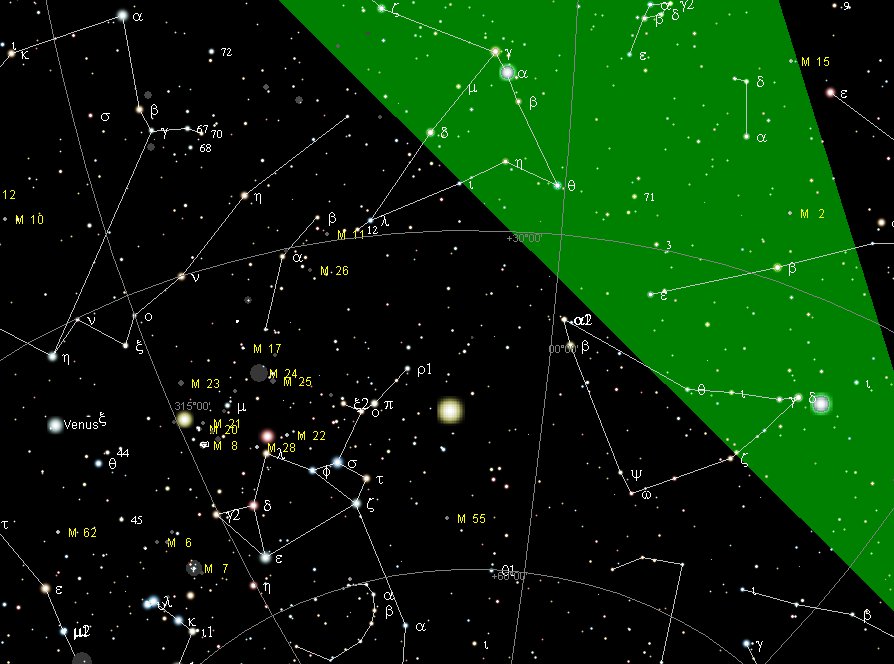65. Possibly the ancient Dogon way of counting on base 8 corresponded to the way of an ancient era - presumably before the Deluge - when they had looked to the face of the Moon and the stars in order to get answers. 360 / 8 = 45, 104 / 8 = 13, and 4 * 64 = 256 = 8 * 32. In this view the right ascension line for the South Pole star, Dramasa, might have been determined to be at "December 25 (*279 ↔ 9 * 31).
In March 1 AD 2024 the planet Mars will here stand prepared to jump across this right ascension line - connecting χ Capricorni with Dramasa - and maybe this explains why the Romans regarded 'March 1 as the last place for the old year, viz. before the arrival of the Kalends of March: ... The leap day was introduced as part of the Julian reform. The day following the Terminalia (February 23) was doubled, forming the 'bis sextum - literally 'double sixth', since February 24 was 'the sixth day before the Kalends of March' using Roman inclusive counting (March 1 was the 'first day') ... The pair of planets on either side of the Sun are Saturn (left) and Mercury (right). And Venus is similarly paired to Mars.
When Mars a little later should be at Φ Capricorni in March 6 AD 2024 (day 65) it can be thought of as day 5 after March 1. In my structure "December 25 will here automatically occur twice (bis) - which in the view of the Easter Islanders ought to have been considered as lucky.
As we have found out the star named Outstretched (Mebsuta) ought to have played an important role:
In the distance 182 days from Ga2-6 (36) to Ga8-15 (218) the 'Martian hedgehog' appears to have walked ahead from April 14 to January 22, in 365 + 22 - 104 = 283 steps, from Mebsuta (ε Gemini) to the day after Vega - which was 3 days after Kaus Borealis (λ Sagittarii).in the t-pot:
Looking again, I am once again able to pinpoint the time place for Mars close to λ Sagittarii not to January 22 AD 2024 but to January 13 - which is Significant because 365 + 13 = 378 (→ 13 * 29 + 1) surely should allude to the synodic cycle of Saturn (Cronos → Chronos). ... The Latin Cronos was called Saturn and in his statues he was armed with a pruning-knife crooked like a crow's bill: probably a rebus on his name. For though the later Greeks liked to think that the name meant chronos, 'time' because any very old man was humorously called 'Cronos', the more likely derivation is from the same root cron or corn that gives the Greek and Latin words for crow - corone and cornix. The crow was a bird much consulted by augurs and symbolic, in Italy as in Greece, of long life. Thus it is possible that another name for Cronos, the sleeping Titan, guarded by the hundred-headed Briareus, was Bran, the Crow-god. The Cronos myth, at any rate, is ambivalent: it records the supersession and ritual murder, in both oak and barley cults, of the Sacred King at the close of his term of office; and it records the conquest by the Achaean herdsmen of the pre-Achaean husbandmen of Greece.At the Roman Saturnalia in Republican times, a festival corresponding with the old English Yule, all social restraints were temporally abandoned in memory of the golded reign of Cronos. I call Bran a Crow-god, but crow, raven, scald-crow and other large black carrion birds are not always differentiated in early times. Corone in Greek also included the corax, or raven, and the Latin corvus, raven, comes from the same root as cornix, crow. The crows of Bran, Cronos, Saturn, Aesculapius and Apollo are, equally, ravens ...
None of my listed stars would be visible close to Mars in January 22 and therefore I had changed from the heliacal view to the nakshatra view - from the vacant place *282 to *100 + *182.
Is this spectacle not the opposite of how Mars earlier had moved when retrograde?
When retrograde the calendar days moved ahead while Mars stayed behind - like Emansor - ... the bird, being sent with a cup for water, loitered at a fig-tree till the fruit became ripe, and then returned to the god with a water-snake in his claws and a lie in his mouth, alleging the snake to have been the cause of the delay. In punishment he was forever fixed in the sky with the Cup and the Snake; and, we may infer, doomed to everlasting thirst by the guardianship of the Hydra over the Cup and its contents. From all this came other poetical names for our Corvus - Avis Ficarius, the Fig Bird; and Emansor, one who stays beyond his time; and a belief, in early folk-lore, that this alone among birds did not carry water to its young ... as if feeling attraction from his 6 'mothers' in the Pleiades. ... Skanda (literally 'the jumping one' or 'the hopping one') is the planet Mars, also called Kartikeya, inasmuch as he was borne by the Krittika, the Pleiades. Mbh. 9.44-46 (Roy trans. vol. 7, pp. 130-43). It should be emphasized, aloud and strongly, that in Babylonian astronomy Mars is the only planetary representative of the Pleiades. See P. F. Gössmann. Planetarium Babylonicum (1950), p. 279: 'In der Planetenvertretung kommt für die Plejaden nur Mars in Frage.' ... The star cluster Krittika ... sometimes known as Kārtikā, corresponds to the open star cluster Pleiades in Indian astronomy and Jyotisa (Hindu astrology). The name literally translates to 'the cutters' ... In Hindu mythology, the god Murugan (Skanda / Subrahmanya / Kartikeya) was raised by the six sisters known as the Krttikā and thus came to be known as Kārtikeya (literally 'Him of the Krttikā'). According to the Mahābhārata, Murugan was born to Agni and Svāhā, after the latter impersonated six of the seven wives of the Saptarsi and made love to him. The Saptarshi, hearing of this incident and doubting their wives' chastity, divorced them. These wives then became the Krttikā ... ... The Mahabharata insists on six as the number of the Pleiades as well as of the mothers of Skanda and gives a very broad and wild description of the birth and the installation of Kartikeya 'by the assembled gods ... as their generalissimo', which is shattering, somehow, driving home how little one understands as yet. The least which can be said, assuredly: Mars was 'installed' during a more or less close conjunction of all planets; in Mbh. 9.45 (p. 133) it is stressed that the powerful gods assembled 'all poured water upon Skanda, even as the gods had poured water on the head of Varuna, the lord of waters, for investing him with dominion'. And this 'investiture' took place at the beginning of the Krita Yuga, the Golden Age ...
Missions from Earth to Mars can for practical reasons occur only about every 2nd year they say, and for voyages in the solar systm it is necessary to use the force of gravity from the planets in order to achieve the strong slingshot movements to escape from the wells of gravitation. ... In his brilliant study of the distribution of the sling in the Pacific tracts, Captain Friederici makes this note (Beiträge zur Völker- und Sprachenkunde von Deutsch-Neuguinea, page 115b): 'Such, though somewhat modified, is the case in Rapanui, Easter Island. The testimony of all the reporters who have had dealings with these people is unanimous that stones of two to three pounds weight, frequently sharp chunks of obsidian, were thrown by the hand; no one mentions the use of slings. Yet Roussel includes this weapon in his vocabulary and calls it hura. In my opinion this word can be derived only from the Mangareva verb kohura, to throw a stone or a lance. So far as we know Rapanui has received its population in part by way of Mangareva.'
|
|||||||||||||||||||||||||||||||||||||||||||||||||||||||||||||||||||||||||||||||||||||||||||||||||||||||||||||||||||||||||||||||||||||||||||||||||||||||||||||||||||||||||||||


















